
 |
Alpinism Home |
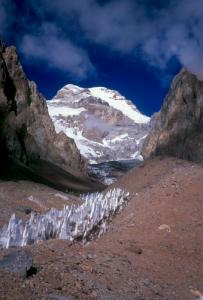
|
Cerro Aconcagua (6962m/22,840ft)Polish Glacier DirectFebruary 13-26, 2006 |
Jeff Witt and I summitted Aconcagua on February 24th, 2006. Below are some pictures I took. I will continue to post more of the TR shortly.
It all started when Jeff sent me a short e-mail in early December about his upcoming trip to Patagonia. He let me know that his partner Matt was going back to Germany in mid February and that he had some extra time for some more climbing. He wrote, "I was contemplating trying Aconcagua if I could round up a partner. I don't know if you have the funds or the free time to take off for three weeks, but I thought I'd see if you were interested. Any interest?"
That's about all it took. Climbing a big mountain with a good friend was something I couldn't pass on. Jeff threw together a streamlined intinerary and I began a crash fitness course. I immediately went on a diet and alternately hiked Mt Si or the Howe St "death stairs" here on Capitol Hill with my big expedition pack.
A little background on Aconcagua. Located in Argentina near the western border with Chile, at 6962 meters or 22,840 feet above sea level, Aconcagua is the highest mountain outside of the Himalaya. Aconcagua viewed from it's various flanks could easily be identified as different mountains. While it's northwestern side is mostly loose rock with no permanent glaciers or snow fields, it's southern face is 3000 meters of hanging glaciers and steep seracs. As R.J. Secor writes in his book, Aconcagua: A Climbing Guide, "Aconcagua doesn't show it's best side to everyone." Our intended route was the Polish Glacier on the northeast flank. It involves moderate ice climbing to 50 degrees with about 3600 feet of glacier travel.
I flew into Santiago Chile, Friday morning February 10th and met Jeff at the airport. As luck would have it, my back pack didn't make it on the plane and was still in Dallas so we made arrangements for it to be sent ahead to Mendoza where we would be staying for the next two days. After eating some lunch we hopped on a bus heading to Mendoza and settled in for the 7 hour ride. I learned from Jeff that long bus rides are part of the deal when travelling in Chile and Argentina, particularly the southern area commonly known as Patagonia. Our bus was very nice with reclining seats, air conditioning, and even on-board movies for entertainment.

|

|
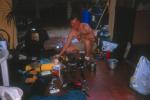
|
Once in Mendoza, we took a taxi from the bus station to Plaza Independencia where we checked into Hostel Independencia. After settling in, we headed out to the Plaza for some dinner and to take in the night life. The Plaza was filled with booths where vendors were selling handicrafts and jewelry. Every evening there was something going on with jugglers, mimes, or bands.
We spent the next morning picking up our climbing permits, maps, postcards, extra food, and fuel for our stoves. That afternoon we organized our packs and contacted a mule company and arranged transportation to the trailhead. I had arranged with the American Airlines in Santiago to have my pack put on a plane to Mendoza and then delivered to our Hostel that evening. All seemed to be set so we went out for dinner. We went back to the same Pizzeria and while we were sitting at our table clouds rolled in and it started to sprinkle rain. A few minutes later a full downpour was upon us with tables and chairs blowing over. Soon I was the only patron sitting outside under my lonely umbrella. I commented to Jeff, "I wonder what this weather is doing on the mountain?" Jeff replied, "Doesn't matter- we're not there!"
We had planned to leave the next morning for the mountain, but we were set back a day when my backpack didn't arrive from the airport. Our bus that was to take us to the trailhead didn't leave until 9:30pm so I got up a 6am that morning and took a taxi to the airport to pick up my pack in person. Customer service doesn't exist at American Airlines at the Mendoza Airport. Although I spoke with their staff at 7am, I had to wait until 9:45am to have the same staff retrieve my bag for me. Wonderful.
The following morning we were finally on the bus heading up to Punta de Vacas or the trailhead for our route. In our planning we had decided to get the "most bang for our buck" by making a complete traverse of the mountain by approaching via the eastern Vacas Valley and descending the western Horcones Valley. From the map it looked like it would only add one difficult day of carrying all our gear over a 6000m pass, but then we would be able to shave a day off the descent by taking the shorter Horcones Valley route out.

|
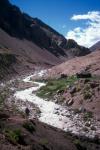
|
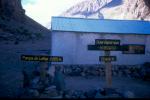
|
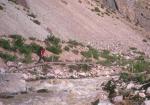
|
After dropping off our 65kg of gear with the LosPuquois Mule Company, we headed back down the road to the trailhead and began our trip. It was a beautiful day and we were full of anticipation and energy. At least I was. Jeff wasn't looking forward to the 25 miles and 3 days of hiking or "slogging" up the valley to the Plaza Argentina base camp. His spirits were lifted when 14km later we arrived at the Las Lenas camp and found that the outhouse actually contained an honest to God porcelain toilet! We mentally prepared for all the hardships that we were to endure on this trip and an outhouse (let alone real toilet) was the least of our expectations. Wanting to the true "expedition hardship experience", this unexpected luxury weighed on our consciences for all of about...2 seconds!
At camp we met several climbing parties who were on their way out. As we greeted each party we were bursting with questions, seeking beta on the route. We asked each about their experience and two American and British parties told of a snowstorm in late January that hit the upper mountain and left chest deep snow on the Polish Glacier. They let us know that the Polish Glacier hadn't seen an ascent since early January. Their weary expressions --sunken eyes, peeling skin, chapped lips, dirty faces mixed with sweat-- made me more than a little concerned about the chances of climbing our intended route. But since it would be at least a week until we were at high camp the conditions had time to improve.

|
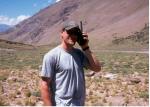
|

|
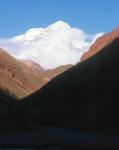
|
The next morning we woke with the sun, packed up and continued 15km up the valley to Casa de Piedra. A few hundred yards out of the camp we found a nice metal bridge to cross the river on. Here we caught up with the mules carrying the rest of our gear. Until now I only had a short sleeved cotton t-shirt so my hands and forearms were a nice lobster color. From the rest of the trip on I had long sleeve shirts and I religiously applied sunscreen. The Muleteers were staying in the "stone house" that the camp is named after and invited us over to share in some asado or Argentine bar-b-que. The afternoon wind and rain picked up, so the south side of the hut offered some shelter. The men were dressed in the traditional guacho style with knitted berets, cord knickers, and a handwoven alpaca poncho. Their friendliness easily trumped the language barrier when they smiled, waved us toward them with their leathery hands, and offered us warm food. They motioned with their hands to sit next to the wall so we were out of the rain. We were handed a simmering beef rib on a piece of bread. The meat melted in our mouths and tasted of the smoke from the glowing coals. They also shared a cup of some Coca-Cola/Wine mixture that was pretty interesting.
Day three began with an invigorating river crossing. Here we left the Vacas Valley and headed up the smaller Relinchos Valley to Plaza Argentina or the base camp for our route. The distance was only 12km but we gained 1000m. This valley was much smaller and steeper. We spotted a guanaco near the mouth of the valley high on a sunny, dry slope among the rocks, gingerly stepping over hummocks of grass. Guanacos, alpacas, llamas, and vicunas are all part of the camelid family.
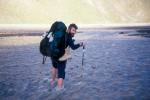
|
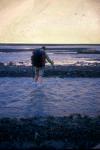
|

|
It was nice to finally be gaining in elevation. A few hours into the hike we came to a spot where the valley widened and the river became wide and shallow. We saw a party on the other side of the river who stopped at a narrow spot, took off their boots and waded across. The memory of the cold water from our morning crossing was still fresh in our minds so we decided to continue hiking up the valley to search for a spot we could jump or walk across without taking off our boots.
After a while it became apparent that the first spot we saw was indeed the best. Not wanting to backtrack we picked out the best possible place to cross. It involved a double jump. One four foot jump to a partially submerged boulder then a five foot leap to a rock on the other side. Jeff went first. He made a valiant first jump but his tennis shoe slipped off the rock and he was quickly up to his knee. At that point he just waded the rest of the way across. I fared a little better. I used my trekking poles to balance as I hopped out on the first boulder. Then I followed Jeff's example and made two quick steps in the river and was quickly on the other side. My Mammut pant legs acted like gaiters over the tops of my boots, and the boots themselves had a Gore-Tex lining so I was fairly dry. I tried not to mention this as I waited for Jeff to wring out his socks and shoes.
Safely on the other side, we picked up the trail and continued to make our way up to Plaza Argentina. Clouds often rolled in during the afternoons and today's clouds brought with them some light snow and hail. The snow stopped by the time we arrived at Plaza Argentina located at 4200 meters. It was really strange to see so many tents and permanent structures at an elevation close to the height of Mt Rainier back home.
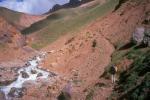
|
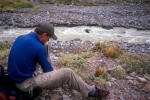
|
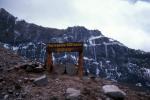
|

|
We checked in with the Park Service Rangers and showed them our papers. Later that afternoon the camp doctor would take our blood pressure and measure our blood/oxygen levels. The mules with our gear had already arrived so we retrieved our three duffel bags and found a site to pitch our tent. There was a large semi-permanent tent that housed the mess-tent where you could buy real meals, for a price. Breakfasts were $20 US, dinners were about $25 and Cokes and beers were $5 a can. Since there was a large table, chairs and recent magazines here many people used the cook tent as a community lounge to relax in. Here we met a Chilean team heading down and two Finnish climbers who were heading up to Camp 1 the next day. The most popular question asked is, "Where are you from?" When the Fins asked us Jeff replied, "The States, Jackson, Wyoming and Seattle", the Fins replied, "I thought so. Your english is too good." We got a chuckle out of that.
The next day was supposed to be a rest day for us to help with the acclimatization but since we felt pretty good we took light packs and headed up the trail to Camp 1 to scout it out. The trail brought us along the edge of the Relinchos Glacier and we got our first up close views of the famous penitentes. At around 4800 meters (15,700 feet) we met up with the Finns who had stopped for a break. They were carrying all of their gear up to Camp 1 and were weighed down with heavy packs. We learned that they had been in Base Camp for several days and were fighting colds and flu. We wished them luck and headed back down.
Jeff and I had wished that we had brought a load of gear up with us since we were going to have to carry it all up to Camp 1 over the next two days. From here on up we would have no more use of the mules so we would be making "carrys" of our gear up to our next higher camp, caching it, then descending back down for the night. This is the tried and true formula for climbing high mountains and it serves two purposes. One, it is the only way to move all of your gear and equipment up the mountain (other than hiring a porter for $200 a load) and Two, it helps in the acclimitization process. By ascending to a higher elevation and then descending to your previous level it gives your body a "taste" of what is to come and allows it to prepare.
The next day we made a full carry up to Camp 1. We knew that this would be our hardest day since we were now carrying all the food, fuel, and climbing equipment that the mules had been carrying previously. Our subsequent carrys would be easier because we were depleting our food and fuel weight each day. On this first carry, we basically hauled up everything the mules had been carrying. The only thing we left for the next day's carry were the items we had already been carrying to this point (tent, stove, sleeping bag, clothes) plus two days worth of food.
It was a rough day for me. The mules had been carrying 130lbs of equipment and roughly half of that was now on our backs. Earlier we had been grumbling at the high cost of the mule service ($240 US for the trip in, alone) but now that seemed like a pretty good deal. Slowly but surely we made our way up to Camp 1. If carrying this load to 4800 meters (15800 feet) wasn't enough, the last 200 meters was steep, loose scree and sand. Fun!
Jeff greeted me at Camp 1 with a hearty congratulations and a big hug. We were now climbing the mountain and making steady progress. We both were a little tired, but otherwise no headaches or nausea commonly experienced at this altitude. We cached the gear and then headed back down to base camp. That evening back at base camp I cooked last of our eggs with our ramen as Jeff sharpened his crampons. It seems that the spires of Patagonia are really giant emory boards! The points of his crampons had been reduced to rounded nubs.
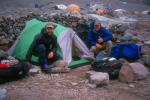
|

|

|
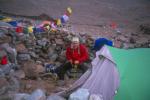
|
The next morning Jeff made arrangements with Mariella, the cook at the mess-tent, to prepare us a wonderful breakfast consisting of hot cereal, a ham and cheese omlette, toasted bread, jam, and tea. It would be our last taste of real food for over a week so we savored every bite. With fully bellies and relatively light packs we cruised up to Camp 1 in a little over two hours a 1000 feet below the scree field we spotted a large guided group making their way up. Since there was one camp site in particular that had really nice protection we decided to increase our pace and beat them to it. We quickly gained on them and passed them about 200 feet below the camp. As it turned out, they were only making a carry and weren't spending the night at Camp 1, but it felt good to have made such great time and still feel good.
That night a small storm blew in and dumped a few inches of snow on us. We met up with the Finnish climbers, Nico and Juoni, and invited them over to our tent to play a game. I had thought about bringing a deck of cards, but cards are heavy. So instead I brought a fun, lightweight game, called "Pass the Pigs" (A.K.A. Pig Mania) which involves rolling two rubber pigs like dice. You score points for having the pigs land in various positions. Since Nico and Juoni's english was better than Jeff and my Finnish, we played in english and had the unique opportunity to teach them words such as "Razorback", "Souie!", and "Double Leaning Jowler".
The next day Jeff and I were still feeling good so instead of a rest day we made a carry up to Camp 2 at 5800 meters. We loaded up our packs and followed the long trail up the mountain. After our earlier carry to Camp 1 I commented to Jeff, "that was the worst slog I've ever had the pleasure to have hiked". But Jeff countered, "No, that was the GREATEST slog I've had the pleasure of hiking!". Around 5000 meters a small storm rolled in and brought some snow and some lightning. Being high on a mountain with and ice axe attached to the back of my pack didn't instill a lot of confidence in me. Thoughts of a lightning stike hitting my axe then setting the fuel in my pack on fire were running through my head as I slowly made my way up the trail. Jeff was far ahead at this point so I made the decision to continue up to the next rock outcropping, cache my load and "get the heck out of Dodge!" I found some rocks around 5500 meters and cached the gear and equipment I was carrying and headed back down.
That evening Jeff and I went over to the Finns tent and played Pigs again. Jeff brought his iPod so we could listen to some tunes while playing. We all got a good laugh when the song, "Hot, hot, hot" played. Oh, how nice it would have been to be playing in a grass hut on the beach somewhere while sipping tropical drinks!
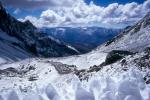
|

|
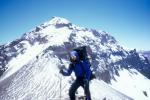
|
We slept in the next day and finally took a rest day. I washed some clothes, and read my Clive Cussler book. Later that afternoon Jeff showed me where he had spent some time building a cairn out on a rock outcropping. We scrambled out to the exposed crag and took some pictures. Far below we could see Plaza Argentina and farther yet the Relinchos Valley and the Vacas Valley from where we hiked in. Progress! We had come a long ways but there was still a long ways to go. The most difficult part of the trip was yet to come.
While I was in the tent reading my book, some climbers passed through camp on their way down the mountain and asked if I needed any food. They had extra and didn't need it or the extra weight. I said no thanks and they moved on. Later when Jeff and I were in the Fins tent playing Pigs, Niko and Juoni showed us the food that they accepted from the descending climbers: two big bags of Oberto Beef Jerkey, an onion, pasta, and other goodness. The climbers came through camp while Jeff was out building his cairn so he didn't know about any of this. Since this was my first real expedition, I didn't know better but Jeff informed me that when people offer you food you say, "Yes!". I explained that I didn't know beef jerkey was involved, otherwise I would have. Oh well, the Fins shared their bounty with us and that evening we had a big pot of pasta with cheese, onions and beef jerkey in it. It was kind of heavy and I don't think the Fins were into it much, but Jeff and I had second and third helpings. There was even some left over in the pot which I warmed up and ate for breakfast the next morning.
After breakfast we broke down camp and said goodbye to the Fins as they were going to spend another day at Camp 1 then come up to Camp 2. Although we had taken most of our gear on the previous carry, I still had to get the gear that I cached below Camp 2 and bring it up as well. I was glad I had my big pack.
My backpack is a Lowe Alpine Kanga Himal which weighs in empty at eight and a half pounds and has a whopping 115 liter capacity. With it's extendable lid, my wife Kim can use it as a bivy sack. I purchased it six years ago from a climber who used it 20 days on Denali (most of those days were spent in his tent due to severe weather) and was moving back to Connecticut. I was glad that it was finally getting used.
I reached the cache and loaded in the gear. I stumbled into Camp 2 with a pretty big pack but I was really excited to be there at the base of our route. Finally we could look up and see the route we had come all this way to climb.
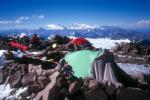
|

|

|
Gazing up at the route we could see no trace of previous attempts. There were two Americans we had met at the lower camps who told us they were intending to climb the Polish Direct. We had hoped that they were successful and that we would find their tracks which we in turn could benefit from. No luck. Everyone else we had spoken to were planning to climb the False Polish route which cuts underneath the Polish Glacier to the right and rejoins the normal route at Refugio Independencia.
We needed to find out what condtion the glacier was in, so we decided to climb up the glacier a little ways to scope it out. Jeff and I talked about the best line to take up the glacier. Originally when we were planning the trip, we talked about climbing the original Polish Glacier route which takes the left hand side of the glacier up to the east ridge and then follows the ridge on up to the summit. This route is lower angled but it is much longer. We learned from guides whom we spoke with in Mendoza that most climbers choose the Direct route over the original Polish Glacier route for this reason. I had an excellent guide book along with me by Harry Kikstra called, Aconcagua: Summit of South America. I picked it up at the Mountaineers bookstore in Seattle, but it is also available from Amazon.com. (I also have the book, Aconcagua: A Climbing Guide by R.J. Secor but I found it a bit outdated. The photos are of climbers with frame packs for crying out loud!) Anyway, the Kikstra book had an excellent photo and description of the Direct route. It described the two major rock bands that needed to be climbed and the various options around and through them.
As we scanned the glacier we talked about what would be the best route for getting up to the first rock band. We decided to stick close to the rocks on the right hand side and then make a traverse up to the gap to the left of the first rock band and right of the seracs. From there it looked straightforward up to the gap in the second rock band called the "bottleneck". We couldn't see much beyond that but we assumed the east ridge wasn't too far above. Looking up at big mountains you often get a foreshortened view. Distances high on the mountain that appear to be short end up being quite long. But in this case we underestimated the lower part of the glacier up to the first rock band. It was much longer than it appeared.
With light packs, crampons, and ice axes we headed up the glacier. In the afternoon sun, the snow was soft but we didn't encounter the deep, unconsolidated snow that we had heard about. We kicked steps up to a small knoll and rested. We had been at it for about two hours and had a nice view looking back down on Camp 2. There had been a little wind but it wasn't bad. Satisfied that the route would "go" we headed back down to camp.
We decided that since we were feeling good and the weather was pretty stable, we should make our summit bid the following day. Back down at camp a guided party with a radio came up from Camp 1 and said that Friday - two days from now - was forecasted to have "perfect weather". We ate dinner and crawled into our tent still planning to climb the next day but we didn't sleep well that night and we hadn't really prepared our packs so it was an easy decision (at 3:30 in the morning!) to sleep in and wait to climb the next day, better rested, better prepared, and with better weather!
The next afternoon we were visiting with some of the other climbers at camp and met a Polish team that had three climbers who were going for the False Polish route and one climber who still wanted to climb the Direct. Jeff and I knew that it was going to be a grind breaking trail up the route so we invited the climber to join our team. Woitek (pronounced "Voy-Tek") was 22 years old and had previously been on Lenin Peak and other high mountains in eastern Europe. He had all the equipment needed for the route so we happily made plans for the next day. We knew it would be a long day so we planned to be ready to go at 4am the next morning.
That evening we got more water to boil for tea to put in Jeff's thermos, and my insulated Sigg bottle. We organized our gear and packs so we would be all ready to go in the morning. Our watch alarms roused us from our rest and we were anxious to get going. Jeff fired up the stove as I got my VBL's situated. VBL's or Vapor Barrier Liners are used in cold climates to prevent moisture from foot perspiration to cause heat loss from socks. Wet socks are cold socks, so if you put your foot in a plastic bag and then into your sock, your sock stays dry and retains heat much better. For the last 6 years I have been collecting Subway Sandwich bags for Denali. My wife's work schedule has not allowed us to get up to Alaska in May so my collection of bags has increased through the years. Kim was as happy to be rid of my collection of bags as I was to be climbing Aconcagua with Jeff!
Breakfast eaten, thermos's filled, packs on, and headlamps blazing we met Woitek and headed out of camp at 4:15am. Woitek did the lions share of trail breaking for the first few hundred feet. For me it's always the most difficult to climb in the dark, at hours when most decent people are sleeping. I took my place in the rear and focused on my breathing. Our minds always fear the unknown and the unseen so I tried to concentrate on inspriring thoughts. I took a page out of my sister-in-law, Penny's, marathon strategy and turned my thoughts to my family. For each step I thought of a family member, a friend, co-worker, neighbor. With my satellite phone calls to Kim, and Kim's e-mail updates I knew that my family and many friends were thinking and keeping us in their prayers on this day.
Woitek, Jeff, and I took turns breaking trail and after a few hours we were at a rock outcropping and took a break for a few bites of food and sips of water. Although the air was fairly calm, the temperature was cold and I'm sure we all had difficulty keeping our toes and fingers warm. But as if on queue, the sun soon rose over the mountains and brought warmth and new found energy.
We pressed on up to the first rock band with a running belay. From there the pitch steepened and Jeff lead up through to the ice field between the first and second rock bands. I took the next section and used ice screws for a long running belay up to some rocks just below the second rock band. I was out of ice screws at the belay so I took the ice tool off my pack and used it as an anchor. I had been using only my mountaineering ice axe up to this point and as it turned out this was the only place I used the ice tool.

|
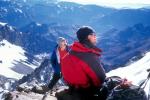
|
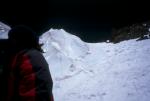
|
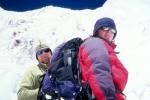
|
Jeff again lead us up through the bottleneck of the second rock band which started off with some steep mixed climbing. This was the most difficult climbing we had done on the entire route. We had been climbing for several hours at this point and I'm sure we all saw the shadows creeping up the face. It had taken much longer than we had expected to climb the route and we still had the long summit ridge to complete. After a long, difficult pitch, Jeff brought Woitek and I up. He was perched on a ridge about 50 meters below the summit ridge. We were now over 6800 meters and every step was real work.
Woitek and I kicked steps up to the summit ridge with Jeff coming up behind us. With the technical sections behind us, we coiled in the rope so we could climb close together up to the summit. I had been feeling good up to this point but a few minutes later fatigue set in. One step. Five breaths. One step. Four breaths. One Step. Ten breaths because four weren't enough. This went on for almost two hours as we slowly worked our way up the long ridge to the summit. Eventually we left the snow and started climbing up a rocky hillock. We spotted a large metal box and knew we must be close. Shortly after we spied the summit crucifix and knew we had made it. It was 8:41pm. The south summit and the top of the enormous south face was in view ahead and below us.

|
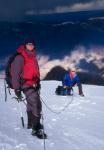
|
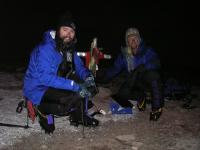
|
We congratulated each other, happy for our accomplishment but tense for the upcoming descent. We spent a few precious moments taking photos of each other at the summit then dug our headlamps back out of our packs and headed down. Jeff and Woitek located the trail where the Normal route descends and were soon on their way down. I would have liked to have stayed longer but sunset is not the time to be lingering on the highest point in the Americas. It was very cold, but we had extra down jackets in our packs, an emergency bivy sack, and a lightweight stove and fuel canister so I knew that even with an unplanned bivy we would be ok. Each of us were tired but none complained of headaches or nausea so we were in fairly decent shape for having just spent 16 hours climbing above 19,000 feet.
The descent was a blur but I remember following Jeff and Woitek down an icy trail for a long time. Eventually we came to the weather worn Refugio Independencia and stopped for a rest. We had drunk the last of our tea and water at the summit so our throats were coarse. As Jeff melted the snow, I remember putting on my down jacket and laying back on the snow and looking up at the stars. It was a magnificient night with the Milky Way sweeping across the sky, overwhelming in its brilliance. My little MSR Pocket Rocket stove and the cold fuel cannister barely melted a cup of water for us all to share. It wasn't enough, but it was all we would get until we reached our tents back at camp. From the notch were the refugio was we could look down and see some lights at Camp 2. Someone was flashing a light up to us. I blinked my light off and on to signal them back. The Fins had told us that they would be watching our progress and we reasoned that it was either them or Woitek's friends who were waiting up for us. We were long overdue, but the three lights of our headlamps would tell them that it was us coming down. Soon enough we would be there to put their worries to rest.
My energy was gone and it was all I could do to keep moving. Woitek and Jeff were out of sight making a bee line for camp. I was hiking alone for some time before I decided to sit down and call Kim. I had hauled the satellite phone to the summit in the event of an emergency and to make a "Guess where I am" call from the summit. But this was the first that it came out of my pack. I told Kim about our success and that we were ok and almost back to camp. The connection must not have been very good because Kim thought I told her that we were on the summit at 8:41 AM. Oh, how I wish we had climbed that fast. I said goodbye and started back down the trail and over the next rise I saw Jeff waiting for me. Woitek had continued on down. Jeff was really tired as well, but he waited for me to make sure I was ok. Several more times I wanted to stop and rest but he kept me moving. As we lumbered down the trail the sky was lit up by a huge fireball meteor! It streaked across the sky and kept getting brighter as it passed into our atmosphere and eventually burned up. Even in our utterly exhausted state, Jeff and I both exclaimed verbally how amazing it was.
It seemed like hours before we stumbled into camp a little before 1 am, tired yet supremely satisfied with our accomplishment.
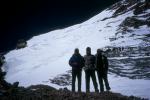
|
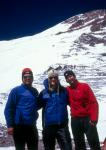
|

|
The next morning we slept in and after breakfast heartily congratulated by the other climbers in camp. Woitek's friends and Niko and Juoni were concerned about our late return until they saw our headlamps from Refugio Independencia. It had been the Fins who had signaled us with their headlamps. The Fins told us that they hadn't overcome their colds and flu so they were heading back down and out the Vacas valley, so we exchanged contact information and made plans to meet in Mendoza for dinner. One climber in Woitek's party had turned back from his attempt on the Normal route and was assisted by some guides back down to the Nido de Condores camp to be looked at by the doctors. His friends were very concerned so Woitek decided to head down with Jeff and I down to Nido de Condores and eventually Plaza de Mulas to check on his condition. The remaining climbers in Woitek's party would descend via the Vacas Valley to meet up again in a few days.
Jeff and I broke down camp for the last time and loaded up our packs. Since my pack was much larger than Jeff's, I took all the bulky items and Jeff took all the heavy items. My pack was long and tall, and Jeff's was very wide when he strapped on all the items that he couldn't fit inside. With no scales we could only estimate, but these were by far the heaviest our packs had been on the trip. BUT, it was all DOWNHILL FROM HERE! Which gave us a great degree of satisfaction.
Not wanting to carry our loads back up to Refugio Independencia at 6000m, we opted to make a descending traverse around to Nido de Condores. Jeff assured me that he had seen a trail on the map that he had back at the hostel. And my topo map showed gradual contours which gave us confidence that our proposed route would go. Well, as it turned out there was no trail and we had to back track up a few hundred feet at one point, but in the end our traverse worked and we ended up at Nido de Condores. We stopped by the Guardaparque hut to confirm the best trail down to Plaza de Mulas. The guard told us that the left trail was more gradual but the right trail was faster. Faster is better. We needed to reach the Plaza de Mulas base camp before 8pm that evening so we could arrange for mules to carry our gear out the following day.
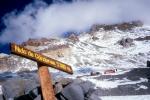
|
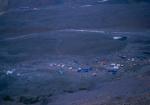
|
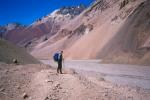
|
The descent wasn't too bad as it was mostly very loose scree and sand. Great for hiking down, but it must be hell to climb up. We were so glad we chose the Vacas route to approach the mountain. Jeff was at the LosPuquios mule company hut at 7:52pm and I was there at 7:58pm. It was quite the base camp with over a hundred tents and huts. After securing mules for the next day, we started to talk about where we wanted to camp. I told Jeff that I wanted to "camp" at the Hotel Plaza de Mulas which is a large mountain hut with beds, showers, and a kitchen!
The Hotel Plaza de Mulas is situated on a ridge above the camp so we gathered together our toiletries from our packs and hiked up to the hotel. We were impressed by it's size. It was quite a large structure for being at 4300 meters and 20 miles away from the nearest road. We checked in and requested our own private room with half board. The only disappointment was that showers were only available until the early afternoon. Oh well. The kitchen was also closed, but the man who runs the hotel saw how much we had been looking forward to a real meal and told us that he could have vegetable soup, and steak sandwiches made for us. Perfecto! We found a table in the dining room and sat down to our feast. We also splurged and ordered a Sprite for Jeff and a Coca-Cola for me. In the corner of the dining room was a large party of more than 20 who were passing around bottles of Champagne, obviously celebrating their successful summit.
After dinner we retired to our room where we piled on the blankets and fell into a deep sleep. It was the best sleep we had for two weeks.
Breakfast was only served until 9am and we still had a very long day of hiking ahead of us, so we begrudgingly stumbled out of bed and walked down to breakfast. The cold temperatures reminded us that we were still high in the mountains. After breakfast we checked out and made our way back to the camp to ready our packs for our hike out. We would put more than 20 miles behind us before we reached the trailhead. But again, it was all down hill, and the mules would be carrying nearly everything. We stilled payed the price with stiff muscles for Jeff, and massive blisters for me. The entire trip up to today, I had only developed a small blister on my big toe. And if I had stopped and applied bandaids and athletic tape I could have prevented them, but I was barn-sour and pain is temporary. I also had a full bottle of Ibuprofen.
We weren't able to reach our bus driver on our satellite phone to arrange to be picked up and driven back to Mendoza. We thought we might be stranded at the trailhead to camp until the morning, but we met some other climbers who told us there was a bus we might be able to get seats on, but we had to be there before 6pm. We arrived at the trailhead in time for the bus but it only brought us back to the LosPuquios hut at Las Penitentes where we retrieved our gear. From there we were on our own to find a ride back down to Mendoza. Our adventure wasn't quite over yet.
Tired and smelly we got a ride to Punta del Inca where we could get a ride on the local bus. It was about 7pm by this time and the bus didn't come until after 9pm, so we tried our hand at hitchhiking. We were on the main highway from Santiago to Mendoza so there were many buses and cars streaming by. SOMEONE should be able to give us a lift. We tried for over an hour with no luck. We did have a good laugh when an older couple in a tiny Swiss made SmartCar approached. This two seater barely has room for two adults let alone two more with two large back packs and three large duffel bags! As the passed us, Jeff and both smiled big and held out our thumbs. The driver took one look at us and took his hands off the wheel and raised them to the side in a mock act of helplessness. The woman in the passenger seat was laughing hard as well.
Resigned to wait until the bus came later that night, we went inside the cafe to order some pizza. We each ordered the Aconcagua special which had ham, tomatoes, green olives, and fried egg. As we were ordering the large group that we had seen celebrating in the Hotel Plaza de Mulas came in and ordered food. We got to talking to two of the climbers and learned that they were waiting for a chartered bus that was going to arrive soon and take them into Mendoza. We had just received our pizzas when the bus came. We quickly grabbed our bags and loaded them on the bus with the other climbers.
It was a long bus ride back to Mendoza with several stops, but on one of the stops the tour leader came back to the bus with a bag full of food! And from a cooler at my feet came bottle after bottle of cerveza. It was quite the festive ride back to Mendoza after the food and drink!
Tired, stinky, full, and ultimately satisfied we arrived back at our hostel, took our first shower in two weeks and made one last climb....into bed! Good night!

|

|
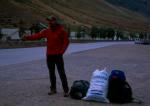
|
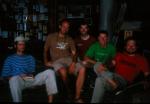
|